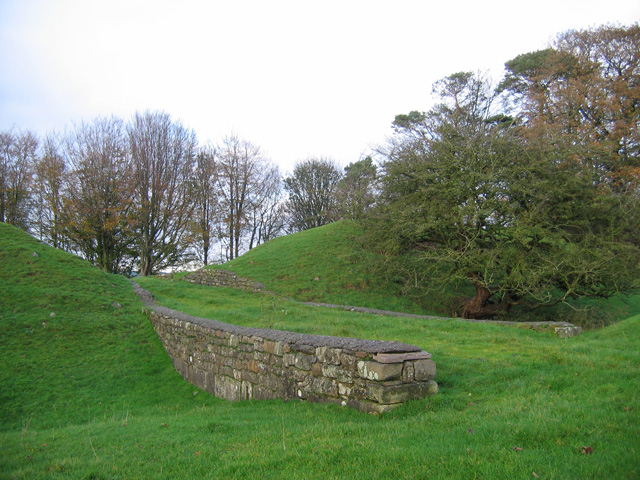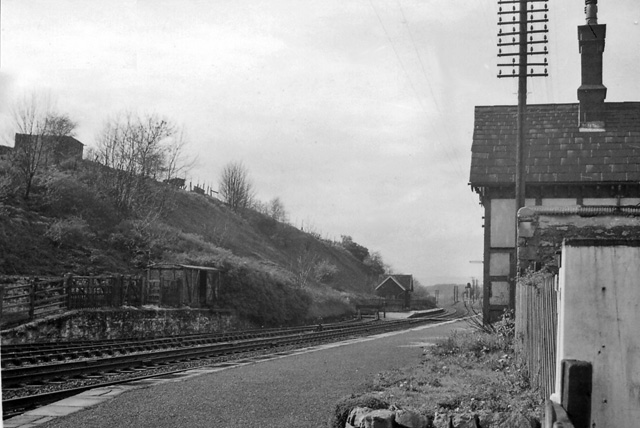|
Claughton, Lancaster
Claughton ( ) is a small village and civil parish in the City of Lancaster in Lancashire, England. The village is on the A683 road east of Lancaster and at the time of the 2001 census had a population of 132. In the 2011 census Claughton was grouped with Roeburndale (2001 pop. 76) to give a total of 223. North of the village is the River Lune, and to the south is Claughton Moor and the fells of the Forest of Bowland. Local government Claughton is part of the Lower Lune Valley ward, which elects two councillors to Lancaster City Council every four years. Industry There is a brickworks, Claughton Brickworks, in the village. Ropeway conveyors, which transport clay from Claughton Moor to the Claughton Brickworks, are suspended above the road ( A683). Religious sites St Chad's Church was closed by the Church of England in 2002 due to a decline in the number of worshippers and the fact that the building was in need of modernisation. The church was part of the Hornby with Cl ... [...More Info...] [...Related Items...] OR: [Wikipedia] [Google] [Baidu] |
St Chad's Church, Claughton
St Chad's Church is in the village of Claughton, Lancashire, England. It is a redundant Anglican parish church, which is recorded in the National Heritage List for England as a designated Grade II listed building. History The original church was built on the site in 1070, and the recorded list of its rectors goes back to 1230. The present church was built on the same site in 1815. In 1869 Hubert Austin designed new tracery for the east window. It cost £270 (equivalent to £ in ), which also paid for the stained glass that was designed by Henry Holiday, and made by Heaton, Butler and Bayne. In 1904 Austin and Paley carried out work on the church, adding a north aisle, a porch, and buttresses, replacing the floor, removing the plaster ceiling, and providing new seating, a pulpit, and a lectern. This work cost about £900 (equivalent to £). The church was declared redundant on 1 December 2002, due to a decline in the size of the congregation and because of the need for ... [...More Info...] [...Related Items...] OR: [Wikipedia] [Google] [Baidu] |
Tom Scott (entertainer)
Thomas Scott is a British YouTuber and web developer. His self-titled YouTube channel offers educational videos across a range of topics including history, geography, science, technology, and linguistics. He also has four other channels: ''Matt and Tom'' (featuring Matt Gray), ''Tom Scott plus'' (which features collaborations with a number of other creators), ''The Technical Difficulties'' (which features him with the other members of the comedy troupe of the same name) and ''Lateral with Tom Scott'' (a podcast based on his 2018 game show of the same name). his five YouTube channels have collectively gained over 6.88 million subscribers and billion views. Early work Originally from Mansfield, Nottinghamshire, United Kingdom, Scott graduated from the University of York with a degree in linguistics and English language, and later earned a Master of Arts in educational studies. While at university, in 2004, Scott produced a website parodying the British government's "Prepari ... [...More Info...] [...Related Items...] OR: [Wikipedia] [Google] [Baidu] |
Westmorland Gazette
''The Westmorland Gazette'' is a weekly newspaper published in Kendal, England, covering "South Lakeland and surrounding areas", including Barrow and North Lancashire. Its name refers to the historic county of Westmorland. The paper is now owned by the Newsquest group, forming part of Westmorland Gazette Newspapers, which includes the weekly freesheet ''South Lakes Citizen'' and other titles. It has an office in Ulverston in addition to its Kendal base. The circulation is about 7,500. It changed from broadsheet to compact format in August 2009. The editor, Vanessa Sims, also edits Cumbrian titles the ''Mail'', the News & Star, The Cumberland News, the ''Whitehaven News'', and the Times & Star. History The newspaper was founded on May 23, 1818. Among its early editors was Thomas De Quincey, who was in post from July 1818 until his resignation in November 1819. Under his editorship, the newspaper covered topics such as contemporary philosophy. It has been suggested that De Quincey's ... [...More Info...] [...Related Items...] OR: [Wikipedia] [Google] [Baidu] |
Skipton
Skipton (also known as Skipton-in-Craven) is a market town and civil parish in the Craven district of North Yorkshire, England. Historically in the East Division of Staincliffe Wapentake in the West Riding of Yorkshire, it is on the River Aire and the Leeds and Liverpool Canal to the south of the Yorkshire Dales. It is situated north-west of Leeds and west of York. At the 2011 Census, the population was 14,623. The town was listed in the 2018 ''Sunday Times'' report on Best Places to Live in northern England. History The name Skipton means 'sheep-town', a northern dialect form of ''Shipton''. Its name derives from the Old English ''sceap'' (sheep) and ''tun'' (town or village).The name is recorded in the ''Domesday Book'' of 1086. It was important during the English Civil War and was the site of prisoner of war camps during the First and Second World Wars. Skipton Castle was built in 1090 as a wooden motte-and-bailey by Robert de Romille, a Norman baron. In the 12th ... [...More Info...] [...Related Items...] OR: [Wikipedia] [Google] [Baidu] |
Morecambe
Morecambe ( ) is a seaside town and civil parish in the City of Lancaster district in Lancashire, England. It is in Morecambe Bay on the Irish Sea. Name The first use of the name was by John Whitaker in his ''History of Manchester'' (1771), when he refers to the "æstury of Moricambe". It next appears four years later in ''Antiquities of Furness'', where the bay is described as "the Bay of Morecambe". That name is derived from the Roman name ''Moriancabris Æsturis'' shown on maps prepared for them by ''Claudius Ptolemœus'' (Ptolemy) from his original Greek maps. At this distance in time it is impossible to say if the name was originally derived from an earlier language (e.g. Celtic language) or from Greek. The Latin version describes the fourth inlet north from Wales on the west coast of England as Moriancabris Æsturis. Translated, this gives a more accurate description than the present name of Morecambe Bay as the Latin refers to multiple estuaries on a curved sea, not a ... [...More Info...] [...Related Items...] OR: [Wikipedia] [Google] [Baidu] |
Hornby, Lancashire
Hornby is a village and former civil parish from Lancaster, now in the parish of Hornby-with-Farleton, in the Lancaster district, in the county of Lancashire, England. The village is on the A683 and at the confluence of the River Wenning and Lune In 2011 the built up area had a population of 468. In 1881 the parish had a population of 358. History Hornby was recorded in the Domesday Book as ''Hornebi''. Hornby was a township and chapelry in Melling parish. From 1866 Hornby was a civil parish in its own right until it was merged with Farleton on 24 March 1887 to form "Hornby-with-Farleton". Amenities Hornby has a church called St Margaret's Church on Main Street, with its octagonal tower a county house called Hornby Castle which overlooks the village. It was started in the 13th century as a replacement for Castle Stede. The tower is 16th-century but the rest was constructed during the 18th and 19th centuries. Despite the castle now being divided into flats, it is still ... [...More Info...] [...Related Items...] OR: [Wikipedia] [Google] [Baidu] |
Wennington Railway Station
Wennington is a railway station on the Bentham Line, which runs between and via . The station, situated east of Lancaster, serves the village of Wennington in Lancashire. It is owned by Network Rail and managed by Northern Trains. History Originally opened by the "Little" North Western Railway in 1849 on their line between and , the station was rebuilt and expanded in 1865 prior to the opening of the Furness and Midland Joint Railway from in 1867. Thereafter it became a busy junction, with many passenger trains calling to detach through carriages for Carnforth from the main Morecambe portion if heading west or attaching them if heading east - a bay platform was provided at the east end of the station for this purpose, along with several sidings on the opposite side of the line for locomotive and carriage stabling (all since removed, along with the extra platform line). A number of local services (mainly from the Carnforth line) also originated or terminated there. Much ... [...More Info...] [...Related Items...] OR: [Wikipedia] [Google] [Baidu] |
Lancaster Green Ayre Railway Station
Lancaster Green Ayre railway station was the Midland Railway's station in the city of Lancaster in England. The line between Green Ayre and Morecambe was used for pioneering experimental electrification via overhead wires. The station closed to passengers in 1966 and there are no remains. History Lancaster's first two stations were the Lancaster and Preston Junction Railway's at ''Greaves'' in 1840, and the Lancaster and Carlisle Railway's ''Lancaster Castle'' which superseded it in 1846.Bairstow, p.96 The third station was opened by the Morecambe Harbour and Railway Company (MH&R) on 12 June 1848.Vinter, p.129 The station building was designed by Edmund Sharpe. Originally called ''Lancaster'', it was soon renamed ''Lancaster Green Ayre'', although timetables incorrectly listed its name as Lancaster Green Area until 1870. The line originally ran from Lancaster to . The MH&R soon amalgamated with the "little" North Western Railway, which continued the line eastward from 17 No ... [...More Info...] [...Related Items...] OR: [Wikipedia] [Google] [Baidu] |
"Little" North Western Railway
The North Western Railway (NWR) was an early British railway company in the north-west of England. It was commonly known as the "Little" North Western Railway, to distinguish it from the larger London and North Western Railway (LNWR). The NWR was first leased, and later taken over, by the Midland Railway (MR). The MR used part of the line for its London to Scotland Settle and Carlisle main line. The NWR main line, which ran from Skipton in the West Riding of Yorkshire to Morecambe on the Lancashire coast, gave the MR access to the west coast in an area dominated by the rival LNWR. Part of the line, between Lancaster and Morecambe, was used in the early twentieth century for pioneering overhead electrification. Two-thirds of the line, in North Yorkshire, is still in use today, mainly for local services. Of the dismantled Lancashire section, two-thirds has been reused as a combined cyclepath and footpath. Formation The North Western Railway was incorporated on 26 June 1846 to ... [...More Info...] [...Related Items...] OR: [Wikipedia] [Google] [Baidu] |
Newsquest Media Group
Newsquest Media Group Ltd. is the second largest publisher of regional and local newspapers in the United Kingdom. It is owned by the American mass media holding company Gannett. It has 205 brands across the UK, publishing online and in print (165 newspaper brands and 40 magazine brands) and reaches 28 million visitors a month online and 6.5 million readers a week in print. Based in London, Newsquest employs a total of more than 5,500 people across the UK. It also has a specialist arm that publishes both commercial and business-to-business (B2B) titles such as ''Insurance Times'', ''The Strad'', and ''Boxing News''. History Newsquest was founded in 1995 when U.S. private equity partnership Kohlberg Kravis Roberts financed a £210 million management buy-out of the Reed Regional Newspapers group of British papers from Reed Elsevier. In 1996 Newsquest swapped its Yorkshire titles for Johnston Press’s Bury, Lancashire area titles and £9.25 million, sold some of its titles in th ... [...More Info...] [...Related Items...] OR: [Wikipedia] [Google] [Baidu] |
Lancashire Evening Telegraph
The ''Lancashire Telegraph'', formerly the ''Lancashire Evening Telegraph'', is a local tabloid newspaper distributed in East Lancashire, England. It is edited by Karl Holbrook. There are around twenty towns in the area, including Blackburn, Burnley, Accrington, Darwen, Nelson, Clitheroe, Colne, and Rawtenstall. The editor is Karl Holbrook, who is also the group editor of Newsquest's newspaper brands across Lancashire and Greater Manchester, including The Bolton News, Bury Times, The Oldham Times and Salford City News. The newspapers are owned by Newsquest, a division of Gannett, a firm based in the United States. History The newspaper was founded by Thomas Purvis Ritzema, a young newspaper manager, who purchased two shops at 19 and 21 Railway Road, Blackburn, for the launch of his venture. The first copy appeared on the streets on 26 October 1886, and sold for a ha’penny. It was known then as the ''Northern Daily Telegraph'', and it was the first evening newspaper to b ... [...More Info...] [...Related Items...] OR: [Wikipedia] [Google] [Baidu] |







